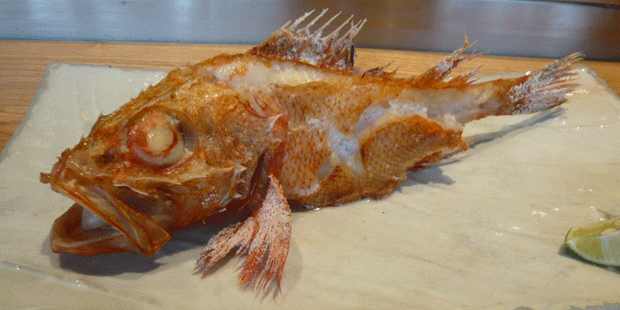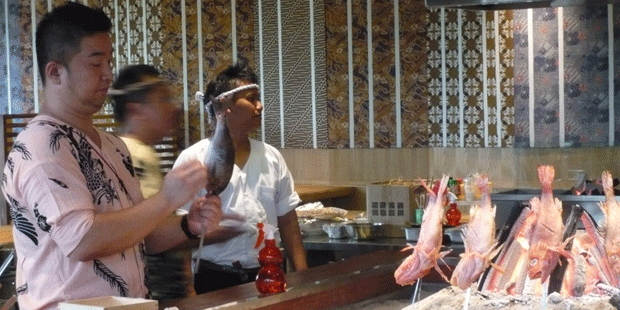 |
| Kinki fish ready to eat. This fish is processed by Robata, which is baked with sand and charcoal. |
Visit to Japan without enjoying the food has the country
will certainly be a loss moment. Japan besides rich in technology, it is also
rich culinary diversity delicious to eat.
Speaking of Japanese cuisine, maybe people are more familiar
with sushi, rice dishes from a rolled with fresh fish. However, many Japanese
are not known by many people, for example Robata.
Robata or Robatayaki a way with sand and charcoal grilling.
In Japan, how to bake like this come from the northern island of Hokkaido,
while the grilled seafood is coming from the waters around the island.
Robata-style cuisine served in the restaurant is mostly
seafood. There also is seafood from the waters of Japan, such as Kinki fish,
which is also one of the leading seafood at this restaurant.
 |
| Kinki fish. Typical Japanese fish that only live in cold waters in Hokkaido. Fish shape is not too big with fresh rosy skin and big eyes. |
Kinki fish only live in the cold waters of Hokkaido, fresh
red skin color and big eyes. Fish shape is not too big, but the price offered
for one fish is very high, reaching more than one million dollars. In addition
because these fish can only be found in Japanese waters, fish meat texture is
very soft, unlike the usual fish.
How to cultivate fish with Robata very easily. Just like
when grilling fish on the beach, something like that technique. Fish and
stabbed with a bamboo stick on the container containing sand dune. Earlier, on
the sandbar has been burnt charcoal.
Sand used is white sand beaches are guaranteed clean, while
charcoal made from mangrove mangroves so distinct aroma when burned produces
distinctive mangrove.
The condiments were added in the fish was not much, just
sprinkled with salt fish and sprayed fluid sake. Because, says Sonya, Japanese
fish that has had its own peculiar taste, sweeter, savory, although it contains
a lot of water.
Japanese culture
As a typical Japanese restaurant, Takumi Robata & Sushi
brings visitors coming as if it is the real Japanese restaurant. Once inside,
visitors are greeted by Japanese greeting servants.
There will be one waitress who guide called "Hi! Okyaku
same goanaisimasu!" which in the Indonesian language, meaning roughly tell
when guests come. Then all the waiters in the restaurant will be answered in
unison with "Hi! Irassamase washoi!"
It will also take longer when there are visitors going home.
Guests were greeting "Hi! Okyaku same akkari desu!" and was greeted
with a "Hi! Arigatou gozaimasta!"
Another typical Japanese impression visible from the
interior of the restaurant. The walls and floor inside the restaurant made of
wood, implying elegant simplicity.
The concept of open kitchen was made, visitors can witness
the process of making dishes, ranging from processing, and materials are made,
presentation, to food hygiene.
 |
| How to processing fish Robata. Fish pierced with bamboo and baked with charcoal on top of the container that contains a sand dune. |
Share This Article To Others :


0 comments:
Post a Comment